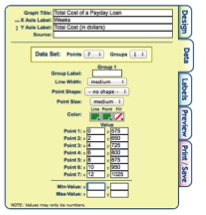
Grades 9-12

Don't have an account yet? Sign up for free
Don't have an account yet? Sign up for free
Nearpod version available
Students will be able to:

In this personal finance lesson, students will learn how a payday loan works.
Payday loans are used by consumers to meet short-term needs for cash. A typical two-week payday loan with a $15 per $100 fee equates to an annual percentage rate (APR) of almost 400%. The APR is the percentage of the principal of a loan to be paid as interest in one year and provides a way to compare loans. In this lesson, students will learn that many users of payday loans pay much more than they initially borrowed because of the costs of multiple renewals or rollovers. A rollover occurs when a borrower cannot repay the payday loan in full at the end of the term (usually two weeks) and then must continue the loan or take out a new one. Students will also use formulas to calculate the total cost of the loans and the APR.
| Know | Want to know | Learned |
|
|
| Weeks | Total Paid |
|
|
|
|
|
|
|
|
|
|
|
|
|
|
|
|
|
|
|
|
|
| Weeks | Total Paid |
|
0 |
|
|
2 |
|
|
4 |
|
|
6 |
|
|
8 |
|
|
10 |
|
|
12 |
|
| Weeks | Total Paid |
|
0 |
575 |
|
2 |
650 |
|
4 |
725 |
|
6 |
800 |
|
8 |
875 |
|
10 |
950 |
|
12 |
1025 |


The end result should appear as the one below. If desired, adjust the appearance of the graph by manipulating various aspects of the graph. In particular, adjust the minimum value of x to 0 and the maximum value of x to be 20 on the data tab. Update the graph and discuss the change. You can see more of the graph; however, the line does not extend. If you were graphing an equation for a line, it would continue. However, this is based solely on a set of data points.

Total cost = Loan amount + Finance charge(1 + Number of Rollovers)
or
T = L + F(1+R)
Total cost = Loan amount + Finance charge(1 + Number of Rollovers)
T = L + F(1+R)
t = 500 + 75(1+2)
t = 500 + 75(3)
t = 500 + 225
t = 725
APR = (finance charge/total amount financed) x (number of weeks in a year/number of weeks in term of loan) x 100
or
APR = (finance charge/total amount financed) x (365/number or days in term of loan) x 100
APR = (finance charge/total amount financed) x (number of weeks in a year/number of weeks in term of loan) x 100
APR = (75/500) x (52/2) x 100
APR = .15 x 26 x 100
APR = 390%
Note: you can leave the x100 off in the equation, but you would need to convert your answer from a decimal (3.9) to a percent (390%).
APR = (finance charge/total amount financed) x (number of weeks in a year/number of weeks in term of loan) x 100
APR = (60/600) x (52/2) x 100
APR = .1 x 26 x 100
APR = 260%
APR = (finance charge/total amount financed) x (number of weeks in a year/number of weeks in term of loan) x 100
APR = (80/700) x (52/2) x 100
APR = .11 x 26 x 100
APR = 286%
APR = (finance charge/total amount financed) x (number of weeks in a year/number of weeks in term of loan) x 100
APR = (90/750) x (52/2) x 100
APR = .12 x 26 x 100
APR = 312%
Multiple Choice
Constructed Response
Mary Ellen is comparing offers for payday loans from two different companies. She needs to borrow $600. While she knows both payday lenders loan money for two weeks at a time, she doesn’t feel that she will have the money to pay it off in just two weeks. She will pick up extra hours at work to save the money and hopes to pay it off in eight weeks. What would the total cost be at each lender? How much more expensive is the most expensive offer? Show your work.
Fast Cash advertises a finance charge of $90 for a $600 loan. Cash Now advertises a finance charge of $18 for every $100 you borrow.
[For each lender, the number of rollovers or R would be (8/2) or 4.]
Fast Cash:
Total cost = Loan amount + Finance charge (1 + Number of Rollovers)
T = L + F(1+R)
t = 600 + 90(1+4)
t = 600 + 90(5)
t = 600 + 450
t = $1,050
Cash Now:
Before using the formula, the finance charge also needs to be determined. Since she would borrow $600, the rate of $18 for every $100 borrowed needs to be calculated as (600/100)x18 = 6 x 18 = 108.
Total cost = Loan amount + Finance charge (1 + Number of Rollovers)
T = L + F(1+R)
t = 600 + 108(1+4)
t = 600 + 108(5)
t = 600 + 540
t = $1,140
Using Fast Cash would cost Mary Ellen $1,050 while using Cash Now would cost her $1,140. Cash Now would be $90 more expensive.

Grades 9-12

Grades 6-8, 9-12

Grades 9-12

Grades 9-12
